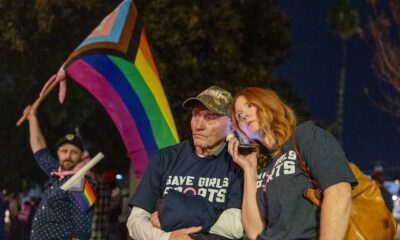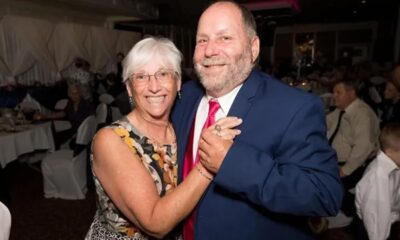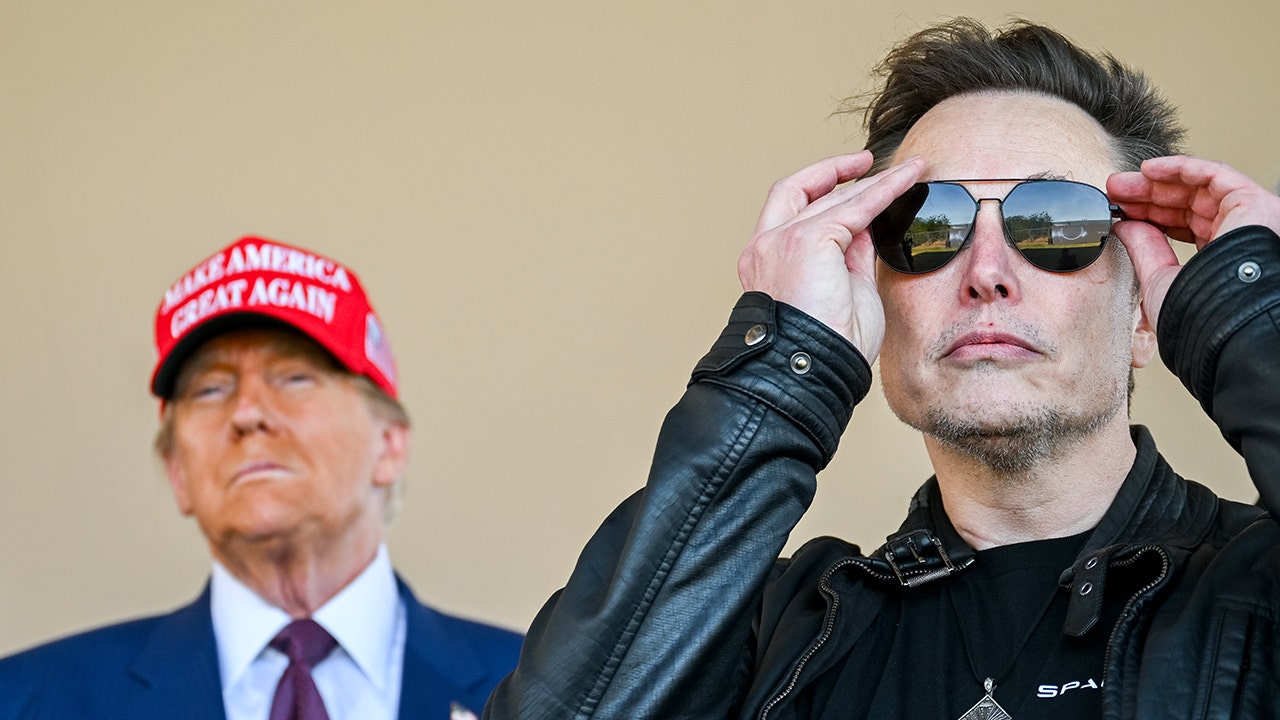Culture
Do You Know These Military-Themed Books That Became Movies?

Welcome to Great Adaptations, the Book Review’s monthly quiz about books that have been made into television shows, movies, theatrical productions and more. In honor of Veterans Day later this week, this month’s challenge is about military-themed books — fiction and nonfiction — that were transformed into films. Tap or click your answers to the five questions below.

Culture
Book Review: ‘The Granddaughter,’ by Bernhard Schlink

THE GRANDDAUGHTER, by Bernhard Schlink. Translated by Charlotte Collins.
When it comes to women revealing what they really think about their families after they die, it’s hard to top Faulkner’s Addie Bundren, reflecting from beyond the grave on the grudges and loathing she lived with as the unwilling matriarch of a dysfunctional Mississippi brood. A century later in Germany, the dead woman at the center of Bernhard Schlink’s new novel, “The Granddaughter,” gives Addie a run for her money.
Birgit grows up in East Germany after the war and dies in her 70s in unified Berlin. Her husband, a bookseller named Kaspar, finds her body drowned in the bathtub of their well-appointed apartment and can’t tell if her overdose was accidental or intentional. Bereft, he receives a postmortem query from a publisher about the manuscript Birgit was writing, which she never showed him. He finds and reads what seems to be an autobiography of Birgit’s thoroughly embittered life, much of which she kept secret from him: from her young love affair with an older Communist Party officer that left her pregnant and alone, to her passionless marriage to Kaspar in Berlin, where she endured years of triumphalist condescension from West Germans. She writes regretfully and searingly about her hopes to someday meet the daughter she abandoned at birth. All that Kaspar knows for certain is that Birgit turned to alcohol and pills to numb her many pains. “I am not a monster,” Birgit reflects, defensively, regarding the freedom she felt in the moments after letting her newborn go.
Instead of disagreeing, Kaspar finds a new purpose in his dead wife’s failures and frustrations: He decides to find Birgit’s daughter. This premise will feel familiar to readers of Schlink’s previous novels — including his best-selling “The Reader” (1995), which was adapted into an Oscar-winning film — many of which use individual relationships as proxies for examining the ongoing legacies of World War II and the Cold War in his native country. Schlink is not as elusive or cerebral a writer about modern Germany as W.G. Sebald, nor as intense or unflinching a storyteller as Jenny Erpenbeck; but he writes instructive tales that adeptly raise difficult questions and propose appealing answers.
In “The Granddaughter,” translated into clear and accessible English by Charlotte Collins, these answers are found along Kaspar’s journey into the former East Germany, where he eventually tracks down Birgit’s daughter, Svenja, who was raised by her birth father and his wife and never knew about Birgit. In and out of reform school as a teenager, Svenja now leads a quiet rural life with her neo-Nazi husband and 14-year-old daughter, surrounded by fellow proponents of a purist Germany who reject national guilt over the “Holocaust lie” and commit themselves to defending “the glory of the Fatherland” from foreign influence. Meeting them, Kaspar exhibits a measured, even respectful curiosity about their enthusiasm for ideas and attitudes that produced the most destructive period of modern world history. His fair-mindedness throughout the novel is so exemplary it becomes wearisome.
What follows is a rather schematic plot turn in which Kaspar persuades Svenja and her husband to let their daughter, Sigrun — whose “heroes” include Irma Grese, an infamously brutal young guard in the women’s sections of Auschwitz and Bergen-Belsen — visit him in Berlin every few months, in exchange for payments from Birgit’s estate. This they decide after Kaspar has met the couple only twice — a couple who are protective and generally distrusting and knew nothing about Birgit, let alone Kaspar, a week earlier. But the all-too-convenient arrangement allows Schlink do what he really wants to with this novel: stage an intergenerational encounter in contemporary Germany between a responsibly contrite, open-minded, aging postwar German and a rebellious, confidently nationalist post-unification teenager.
And so Sigrun spends more than a year traveling between her home and Kaspar’s, where she has her own bedroom and piano lessons, where the two cook and travel and go to the philharmonic and museums together, and where Kaspar patiently tries to convince her of the authenticity of Anne Frank’s diary. Unsurprisingly, this “Pygmalion”-style denazification project involves giving her books to inform and challenge her worldview, which inevitably leads to conflicts back home.
After disappearing from his life without warning, Sigrun shows up again on Kaspar’s doorstep two years later, needing him to hide her from the police. At 18 she has inherited her mother’s stubbornness, which ironically makes her rebel against Svenja’s “Völkisch” politics and Third Reich nostalgia. She’s eager to fight in the streets for her own vision for Germany — especially against her leftist peers — which Schlink shrewdly conveys as a kind of reactionary idealism to what she perceives as the political mushiness of her parents’ generation.
However disappointed and worried he becomes about Sigrun’s situation, Kaspar remains unconditionally supportive, losing his temper only once, on the perfectly calculated occasion of delivering an impassioned speech in defense of moderation — to a Sigrun who proves, also conveniently, more and more open to her step-grandfather’s perspective.
And so this novel, finally too pleasing and affirming for readers who are rightly worried about political violence and radicalized youth, ends with a dignified old man envisioning a stable, cosmopolitan future for a wayward young girl. Some will read Schlink’s latest as an inspiring fable of intergenerational unity and redemption. Others might find it more like fantasy fiction.
THE GRANDDAUGHTER | By Bernhard Schlink | Translated by Charlotte Collins | HarperVia | 326 pp. | $28.99
Culture
Jason Kelce’s new late-night show needs more Kelce, less comedy: Takeaways

For all the talk of Tom Brady’s TV debut in 2024, few pro athletes have made the transition off the field and into the pop-culture landscape more effectively than Jason Kelce, whose unique professional and personal alchemy includes: notable on-field success, including All-Pro honors, a Super Bowl title in Philadelphia and a role as a lead performer of the Eagles’ “Tush Push”; off-field media stardom as a co-host, with brother Travis, of the wildly popular “New Heights” podcast; and commercial ubiquity (Buffalo Wild Wings and Campbell’s Chunky Soup, among others).
That led to a multiyear deal with ESPN, including participating on “Monday Night Countdown” and, as of 1 a.m. ET on Saturday morning, a new role as late-night talk show host — arguably one of the the most challenging jobs in TV.
Taped in front of a live audience at Philadelphia’s Union Transfer, “They Call It Late Night With Jason Kelce” was the first of a four-week “pop-up” experiment in sports TV leading up to the Super Bowl, and the results were a not-unexpected mix of raucous, ragged and relatable.
Here are key takeaways from the show’s debut:
Kelce’s bearded, beer-swilling “everyman” vibe is at the heart of his charm
And the show leaned right into that. Kelce wore a letterman’s jacket and T-shirt, with jeans and work boots.
He set a tone quickly, asking his audience: “How did we get here?” Actually, his very first words were “Holy s—.” The late-night license to curse was used liberally but not particularly gratuitously (the s-word went unbleeped, the f-word was bleeped).
From the show’s name, logo and intro to its retro-fun set to a few of its bits, there was a running homage to the best of NFL Films. “They Call It Pro Football” was one of NFL Films’ earliest projects, and the appreciation Kelce has for NFL history popped, from a warm studio cameo and toast with Hall of Fame Eagles receiver Harold Carmichael to Kelce’s awe for framed photos of the NFL’s most famous “mangled hands” hanging in the studio.
First pics of Jason Kelce’s new show ‘They Call It Late Night’
📸: @ESPNPR pic.twitter.com/PPKD0lZ2qN
— Kelce Brothers (@kelcebrothers) January 4, 2025
Kelce’s opening monologue gets graded on a curve
That’s because the late-night host monologue in front of an audience is among the most challenging work in all of TV — let alone by someone with limited hosting experience. The audience was friendly and forgiving of the occasional faltering riff, if not laughing their heads off. The bits involving actors — like a segment where Kelce met himself as a 14-year-old and as an older person — were more cringe than comedy.
The second segment shined
The show was at its best in the second segment, when Kelce brought out a roundtable of guests: the rapper and actor Dave “Lil Dicky” Burd, the NFL TV analyst Brian Baldinger and — in an impressive flex by Kelce and ESPN — Charles Barkley.
Their roundtable conversation felt like listening to a podcast in all the right ways — casual and conversational. From his experience co-hosting “New Heights,” Kelce seemed so much more comfortable as a moderator than solo star.
They covered some good “newsy” topics — the Eagles sitting Saquon Barkley before he could try to set the NFL single-season rushing record (Charles Barkley: “I’m glad he’s not playing.”), players’ mindset heading into Week 18 and Detroit Lions coach Dan Campbell. Giving four professional talkers a classic sports-talk framework was a great idea.
The show could use a tighter run time
As the show got deeper into its hour-long run-time, the conceits and viewer experience got demonstrably more strained: A segment where the four panelists were tasked with doing their best impressions of legendary NFL Films voice (and Philly native) John Facenda was derailed by the panelists being totally unprepared to read their cue cards and the content of the cards being clunky and corny. (Burd: “I don’t know what I just read.”)
A final segment featuring four super-fans in a beer-chugging contest felt tacked on and featured the fastest chugger being disqualified for not ending by flipping his mug onto his head as instructed. (Watching it was even more raggedy than describing it.)
The show could — and would — benefit from a tighter run-time (30 minutes makes sense), which would allow it to really zero in on Kelce as an expert moderator of an interesting panel of guests.
The show needs more Kylie
One area where the show should not skimp going forward: Air-time for Kelce’s wife, Kylie, who sits at a table in the wings (“Kylie’s Korner”) and acts as lead voiceover, lamentably used only sparingly in the debut.
Kylie — who recently displaced Joe Rogan as the most popular podcast host on Spotify — is way too talented (and way too big of a star in her own right) to have such a minimal, marginal role. The show would benefit from way more Kylie, and it could easily replace the final two blocks with the couple bantering about topics together — or adding Kylie to the roundtable.
Kylie Kelce is an announcer for “They Call it Late Night with Jason Kelce” ❤️ @latenightwithjk | @JasonKelce pic.twitter.com/QnibuiP3eL
— espnW (@espnW) January 4, 2025
I have a lot of empathy and appreciation for a production team trying something new, and debut episodes are the moment all your fun ideas in the writers’ room meet reality.
In this case, they don’t need the canned bits and actors — they have Kelce, in all his authenticity and talent for holding a conversation; they have Kylie; they have ESPN’s convening power to get big names like Barkley; they have a friendly Philly crowd and a welcoming studio set-up — and they should double down on letting Kelce do what he is best at.
Required reading
(Photo: Andy Lewis / Icon Sportswire via Getty Images)
Culture
2 Books About the Moneyed Class

Dear readers,
When a friend forwarded some fresh ridiculous news about billionaires recently — you might have heard it’s a gangbusters time to be one — I scoffed the scoff of the comfortably righteous. Boo, hiss, the filthy feckless rich! Let them eat crypto, or whatever.
My reading preferences, though, tend to look a lot less proletarian. Tales of the 1 percent take up too many percentages of my personal library, a veritable Davos Forum of prosperity and privilege crammed into wonky Ikea bookshelves. Give me outrageous fortune in all its forms, fiction or non-: old money; new money; money so big it seems bottomless until in a dribble or a rush it’s gone, leaving a wash of disgraced tech moguls and shabby aristocrats in its wake.
All that abundance allows for endless subcategorization: The picks in this week’s newsletter were both published in the 1980s (didn’t they call it the Greed Decade?) but are set in the early years of the 20th century and were written by women who were, you could say, born to the material.
—Leah
“The Shooting Party,” by Isabel Colegate
Fiction, 1980
“The Shooting Party” opens on an English country manor, with a sprawling cast of characters and death on the mantel. But Colegate’s novel mostly swerves away from Agatha Christie territory; it’s not murder so much as class disparity and vast carelessness that snuff out a life in the last pages.
Along the way, Colegate introduces the many houseguests, residents and scurrying servants of Nettleby Park, a bucolic Northamptonshire estate that in the fall of 1913 contains only whispers of the war that will shortly upend the old world order still preserved there. Sir Randolph is hosting a hunt, and it takes a village to sustain the roundelay of white-tablecloth meals, shootable wildlife and social intrigue.
The pheasant body count is high, but most pursuits take place indoors: There is much covert coveting of other people’s partners and simmering rivalries among highborn men for whom day jobs are as foreign as dressing themselves for dinner. The service staff, from the scullery maids to the local laborers hired as “beaters” to bring out the game, have their own romances and resentments, and a lonely little boy spends a lot of time trying to track down his pet duck. Other odd birds emerge, including an earnest vegetarian schoolteacher eager to spread the gospel of animal equality to Nettleby.
Julian Fellowes, the creator of “Downton Abbey,” supposedly gleaned heavy inspiration from “The Shooting Party” (he wrote the introduction to a 2007 reissue). But Colegate has him beat for on-the-job training — her father was a knighted member of Parliament and her mother the daughter of a baronet. And her storytelling is drawn in finer ink than his gilded soap operas, even when the party turns to its final, fatal calamity.
Read if you like: Buckshot, in-depth descriptions of British flora, tasteful infidelity.
Available from: Penguin Modern Classics, or your favored local viscount.
“Once Upon a Time: A True Story,” by Gloria Vanderbilt
Nonfiction, 1985
The über alles of poor little rich girls, Vanderbilt lost her father, the industrialist heir Reginald Claypool Vanderbilt, before her first birthday. He was 45; her mother was 19 and not particularly bound to her husband’s social calendar. (On the night Reginald died at his Rhode Island estate, she was off at the theater in New York City with “a friend of the family,” Vanderbilt writes in “Once Upon a Time,” the second of six memoirs published before her death at 95 in 2019.)
Almost immediately, the custody of baby Gloria became a family power struggle and then a tabloid mainstay. Like the ongoing churn of nannies and chauffeurs she was largely parented by, it was all more or less normalized, though the battle dragged on long enough that her comprehension eventually caught up with the more sordid points of the case: “I tormented myself by imagining that the only clothes I wore were made of newspapers, and on each would be words in those black thick spider letters spelling out what I could no longer pretend not to read.”
Mostly, she pined for the barest crumbs from her mother (also named Gloria), a distant glamourpuss who slept past noon and regularly disappeared to London or Paris or Biarritz with some lover or another. Even when physically present, she was rarely there — taking a preteen Gloria for a promised meeting with her idol, Marlene Dietrich, for example, then ditching her in Dietrich’s driveway for hours while she slipped inside alone.
Vanderbilt recalls all this with the breathless prose of a bygone schoolgirl, crowding the page with whimsical nicknames (Big Elephant, Tootsie Eleanor, the Little Countess), and looping her most fervent words and phrases when she really means-means-means them. Still, it’s hard to resist her guileless takes on what passed for adolescent social events: weekends with William Randolph Hearst or the Prince of Wales; a “Wizard of Oz” premiere gala at the Waldorf Astoria (Judy Garland and Mickey Rooney never showed at the afterparty, nor a single munchkin, though Errol Flynn did).
And you know exactly what she means when she describes a boarding-school classmate as “cold-muffiny.” Vanderbilt was too warm for her world, a Dorothy who probably would have been happier in Kansas but learned to make Oz home.
Read if you like: Drinking soda pop at the Stork Club, vintage issues of Vogue, “scrambled eggs with brandied peaches and champagne” for breakfast.
Available from: Estate sales and eBay, generally.
Why don’t you …
-
Shake the family tree further via Consuelo Vanderbilt’s rococo 1952 memoir “The Glitter and the Gold”?
-
Dip into the preppy-handbook idyll of Will Vogt’s “These Americans”? Jay McInerney (naturally) wrote the foreword.
-
Consider the cautionary tale of Leona Helmsley’s late Maltese, Trouble, the abiding lap-dog heiress of our times?
Thank you for being a subscriber
Plunge further into books at The New York Times or our reading recommendations.
If you’re enjoying what you’re reading, please consider recommending it to others. They can sign up here. Browse all of our subscriber-only newsletters here.
Friendly reminder: check your local library for books! Many libraries allow you to reserve copies online.
-

 Health1 week ago
Health1 week agoNew Year life lessons from country star: 'Never forget where you came from'
-
/cdn.vox-cdn.com/uploads/chorus_asset/file/24982514/Quest_3_dock.jpg)
/cdn.vox-cdn.com/uploads/chorus_asset/file/24982514/Quest_3_dock.jpg) Technology1 week ago
Technology1 week agoMeta’s ‘software update issue’ has been breaking Quest headsets for weeks
-

 Business5 days ago
Business5 days agoThese are the top 7 issues facing the struggling restaurant industry in 2025
-

 Culture5 days ago
Culture5 days agoThe 25 worst losses in college football history, including Baylor’s 2024 entry at Colorado
-

 Sports4 days ago
Sports4 days agoThe top out-of-contract players available as free transfers: Kimmich, De Bruyne, Van Dijk…
-

 Politics3 days ago
Politics3 days agoNew Orleans attacker had 'remote detonator' for explosives in French Quarter, Biden says
-

 Politics3 days ago
Politics3 days agoCarter's judicial picks reshaped the federal bench across the country
-

 Politics1 day ago
Politics1 day agoWho Are the Recipients of the Presidential Medal of Freedom?

















